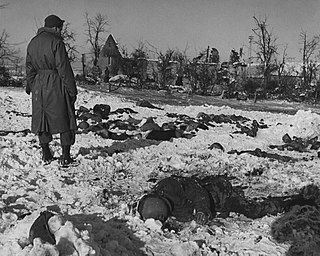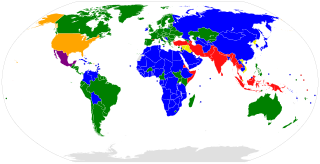Related Research Articles

A war crime is a violation of the laws of war that gives rise to individual criminal responsibility for actions by combatants in action, such as intentionally killing civilians or intentionally killing prisoners of war, torture, taking hostages, unnecessarily destroying civilian property, deception by perfidy, wartime sexual violence, pillaging, and for any individual that is part of the command structure who orders any attempt to committing mass killings including genocide or ethnic cleansing, the granting of no quarter despite surrender, the conscription of children in the military and flouting the legal distinctions of proportionality and military necessity.

The Geneva Convention relative to the Protection of Civilian Persons in Time of War, more commonly referred to as the Fourth Geneva Convention and abbreviated as GCIV, is one of the four treaties of the Geneva Conventions. It was adopted in August 1949, and came into force in October 1950. While the first three conventions dealt with combatants, the Fourth Geneva Convention was the first to deal with humanitarian protections for civilians in a war zone. There are currently 196 countries party to the 1949 Geneva Conventions, including this and the other three treaties.

A civilian casualty occurs when a civilian is killed or injured by non-civilians, mostly law enforcement officers, military personnel, rebel group forces, or terrorists. Under the law of war, it refers to civilians who perish or suffer wounds as a result of wartime acts. The term is generally applied to situations in which violence is committed in pursuit of political goals. During periods of armed conflict, there are structures, actors, and processes at a number of levels that affect the likelihood of violence against civilians.

Collateral damage is any incidental and undesired death, injury or other damage inflicted, especially on civilians, as the result of an activity. Originally coined to describe military operations, it is now also used in non-military contexts to refer to any unwanted fallout from an action.

The law of war is the component of international law that regulates the conditions for initiating war and the conduct of hostilities. Laws of war define sovereignty and nationhood, states and territories, occupation, and other critical terms of law.

Non-combatant is a term of art in the law of war and international humanitarian law to refer to civilians who are not taking a direct part in hostilities; persons, such as combat medics and military chaplains, who are members of the belligerent armed forces but are protected because of their specific duties ; combatants who are placed hors de combat; and neutral persons, such as peacekeepers, who are not involved in fighting for one of the belligerents involved in a war. This particular status was first recognized under the Geneva Conventions with the First Geneva Convention of 1864.
International humanitarian law (IHL), also referred to as the laws of armed conflict, is the law that regulates the conduct of war. It is a branch of international law that seeks to limit the effects of armed conflict by protecting persons who are not participating in hostilities and by restricting and regulating the means and methods of warfare available to combatants.

Protocol I is a 1977 amendment protocol to the Geneva Conventions concerning the protection of civilian victims of international war, such as "armed conflicts in which peoples are fighting against colonial domination, alien occupation or racist regimes". In practice, Additional Protocol I updated and reaffirmed the international laws of war stipulated in the Geneva Conventions of 1949 to accommodate developments of warfare since the Second World War (1937–1945).
A preliminary examination of possible war crimes committed by United Kingdom (UK) military forces during the invasion of Iraq in March 2003 was started by the ICC in 2005 and closed in 2006. The preliminary examination was reopened in 2014 in the light of new evidence.
Proportionality is a general principle in law which covers several separate concepts:

War can heavily damage the environment, and warring countries often place operational requirements ahead of environmental concerns for the duration of the war. Some international law is designed to limit this environmental harm.

Ryuichi Shimoda et al. v. The State was an unsuccessful case brought before the District Court of Tokyo by a group of five survivors of the atomic attacks on Hiroshima and Nagasaki, who claimed the action was illegal under the laws of war and demanded reparations from the Japanese government on the ground that it waived the right for reparations from the U.S. government under the 1951 Treaty of San Francisco.
Distinction is a principle under international humanitarian law governing the legal use of force in an armed conflict, whereby belligerents must distinguish between combatants and protected civilians. Combatant in this instance means persons entitled to directly participate in hostilities and thus are not afforded immunity from being directly targeted in situations of armed conflict. Protected civilian in this instance means civilians who are enemy nationals or neutral citizens outside of the territory of a belligerent power.
Air warfare must comply with laws and customs of war, including international humanitarian law by protecting the victims of the conflict and refraining from attacks on protected persons.

The Geneva Conventions are international humanitarian laws consisting of four treaties and three additional protocols that establish international legal standards for humanitarian treatment in war. The singular term Geneva Convention colloquially denotes the agreements of 1949, negotiated in the aftermath of the Second World War (1939–1945), which updated the terms of the two 1929 treaties and added two new conventions. The Geneva Conventions extensively define the basic rights of wartime prisoners, civilians and military personnel; establish protections for the wounded and sick; and provide protections for the civilians in and around a war-zone.
Accusations of violations regarding international humanitarian law, which governs the actions by belligerents during an armed conflict, have been directed at both Israel and Hamas for their actions during the 2008–2009 Gaza War. The accusations covered violating laws governing distinction and proportionality by Israel, the indiscriminate firing of rockets at civilian locations and extrajudicial violence within the Gaza Strip by Hamas. As of September 2009, some 360 complaints had been filed by individuals and NGOs at the prosecutor's office in the Hague calling for investigations into alleged crimes committed by Israel during the Gaza War.
A legitimate military target is an object, structure, individual, or entity that is considered to be a valid target for attack by belligerent forces according to the law of war during an armed conflict.
The Protocol on Prohibitions or Restrictions on the use of Incendiary Weapons is a United Nations treaty that restricts the use of incendiary weapons. It is Protocol III to the 1980 Convention on Certain Conventional Weapons Which May Be Deemed To Be Excessively Injurious Or To Have Indiscriminate Effects. Concluded in 1981, it entered into force on 2 December 1983. As of January 2023, it had been ratified by 126 state parties.
Human shields are legally protected persons—either protected civilians or prisoners of war—who are either coerced or volunteer to deter attacks by occupying the space between a belligerent and a legitimate military target. The use of human shields is forbidden by Protocol I of the Geneva Conventions. It is also a specific intent war crime as codified in the Rome Statute, which was adopted in 1998. The language of the Rome Statute of the International Criminal Court prohibits "utilizing the presence of a civilian or other protected person to render certain points, areas, or military forces immune from military operations."
In international humanitarian law and international criminal law, an indiscriminate attack is a military attack that fails to distinguish between legitimate military targets and protected persons. Indiscriminate attacks strike both legitimate military and protected objects alike, thus violating the principle of distinction between combatants and protected civilians. They differ from direct attacks against protected civilians and encompass cases in which the perpetrators are indifferent as to the nature of the target, cases in which the perpetrators use tactics or weapons that are inherently indiscriminate, and cases in which the attack is disproportionate, because it is likely to cause excessive protected civilian casualties and damages to protected objects.
References
- Moreno-Ocampo, Luis (February 9, 2006), OTP letter to senders re Iraq (PDF), archived from the original (PDF) on March 27, 2009. See section "Allegations concerning War Crimes" Pages 4,5
- Ryuichi Shimoda et al. v. The State (1963)